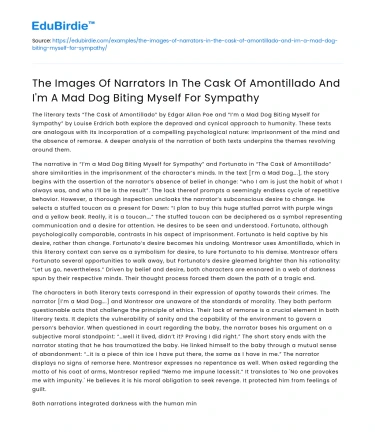The literary texts “The Cask of Amontillado” by Edgar Allan Poe and “I’m a Mad Dog Biting Myself for Sympathy” by Louise Erdrich both explore the depraved and cynical approach to humanity. These texts are analogous with its incorporation of a compelling psychological nature: imprisonment of the mind and the absence of remorse. A deeper analysis of the narration of both texts underpins the themes revolving around them.
The narrative in “I’m a Mad Dog Biting Myself for Sympathy” and Fortunato in “The Cask of Amontillado” share similarities in the imprisonment of the character’s minds. In the text [I’m a Mad Dog….], the story begins with the assertion of the narrator’s absence of belief in change: “who I am is just the habit of what I always was, and who I’ll be is the result”. The lack thereof prompts a seemingly endless cycle of repetitive behavior. However, a thorough inspection uncloaks the narrator’s subconscious desire to change. He selects a stuffed toucan as a present for Dawn: “I plan to buy this huge stuffed parrot with purple wings and a yellow beak. Really, it is a toucan….” The stuffed toucan can be deciphered as a symbol representing communication and a desire for attention. He desires to be seen and understood. Fortunato, although psychologically comparable, contrasts in his aspect of imprisonment. Fortunato is held captive by his desire, rather than change. Fortunato’s desire becomes his undoing. Montresor uses Amontillado, which in this literary context can serve as a symbolism for desire, to lure Fortunato to his demise. Montresor offers Fortunato several opportunities to walk away, but Fortunato’s desire gleamed brighter than his rationality: “Let us go, nevertheless.” Driven by belief and desire, both characters are ensnared in a web of darkness spun by their respective minds. Their thought process forced them down the path of a tragic end.
Save your time!
We can take care of your essay
- Proper editing and formatting
- Free revision, title page, and bibliography
- Flexible prices and money-back guarantee
The characters in both literary texts correspond in their expression of apathy towards their crimes. The narrator [I’m a Mad Dog….] and Montresor are unaware of the standards of morality. They both perform questionable acts that challenge the principle of ethics. Their lack of remorse is a crucial element in both literary texts. It depicts the vulnerability of sanity and the capability of the environment to govern a person’s behavior. When questioned in court regarding the baby, the narrator bases his argument on a subjective moral standpoint: “…well it lived, didn’t it? Proving I did right.” The short story ends with the narrator stating that he has traumatized the baby. He linked himself to the baby through a mutual sense of abandonment: “…it is a piece of thin ice I have put there, the same as I have in me.” The narrator displays no signs of remorse here. Montresor expresses no repentance as well. When asked regarding the motto of his coat of arms, Montresor replied “Nemo me impune lacessit.” It translates to 'No one provokes me with impunity.' He believes it is his moral obligation to seek revenge. It protected him from feelings of guilt.
Both narrations integrated darkness with the human mind. While one focused on the internal conflict of permanence versus change, the other zeroed in on the repercussions of desire in extreme. Aristotle believed that to be virtuous, moderation is required. Fortunato, exhibiting human nature, allows his desire in extreme. Hence, it led to his downfall. Themes of revenge and remorse are incorporated as well. The concept of nature versus nurture is explored, proving that the environment plays a significant role in shaping an individual. Their respective environments resulted in their predisposition to criminal activity.
Did you like this example?
Make sure you submit a unique essay
Our writers will provide you with an essay sample written from scratch: any topic, any deadline, any instructions.
Cite this paper
-
APA
-
MLA
-
Harvard
-
Vancouver
Narrator Images in The Cask of Amontillado & I’m a Mad Dog.
(2021, August 18). Edubirdie. Retrieved December 22, 2024, from https://edubirdie.com/examples/the-images-of-narrators-in-the-cask-of-amontillado-and-im-a-mad-dog-biting-myself-for-sympathy/
“Narrator Images in The Cask of Amontillado & I’m a Mad Dog.” Edubirdie, 18 Aug. 2021, edubirdie.com/examples/the-images-of-narrators-in-the-cask-of-amontillado-and-im-a-mad-dog-biting-myself-for-sympathy/
Narrator Images in The Cask of Amontillado & I’m a Mad Dog. [online].
Available at: <https://edubirdie.com/examples/the-images-of-narrators-in-the-cask-of-amontillado-and-im-a-mad-dog-biting-myself-for-sympathy/> [Accessed 22 Dec. 2024].
Narrator Images in The Cask of Amontillado & I’m a Mad Dog [Internet]. Edubirdie.
2021 Aug 18 [cited 2024 Dec 22].
Available from: https://edubirdie.com/examples/the-images-of-narrators-in-the-cask-of-amontillado-and-im-a-mad-dog-biting-myself-for-sympathy/
copy






 Stuck on your essay?
Stuck on your essay?

